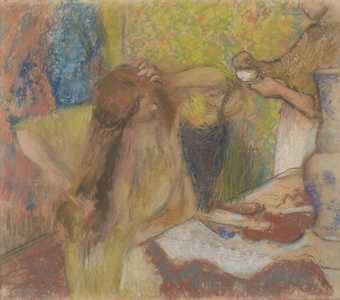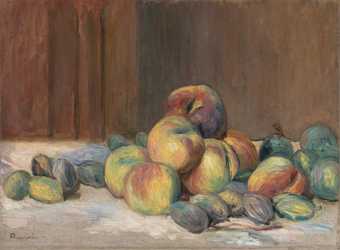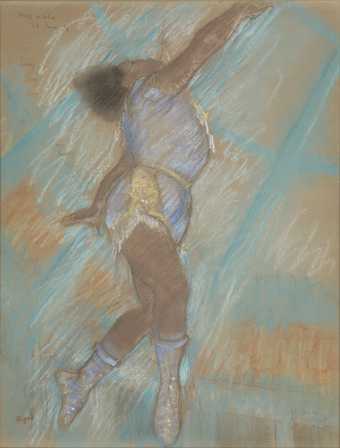
Edgar Degas
Woman at her Toilet
(c.1894)
Tate
Edgar Degas was a French artist born in Paris in 1834. He was supposed to become a lawyer, but he preferred to doodle so he became an artist instead! He mainly drew and painted pictures of everyday life such as this woman brushing her hair.

Auguste Renoir
Peaches and Almonds
(1901)
Tate
Paris was a very exciting place to live if you were a young artist. Lots of artists travelled from all over the world to work there and Edgar Degas met a group of young artists called the impressionists. They wanted to paint scenes from everyday life, like food, people and the countryside. (At that time most art was about grander things such as history or Greek and Roman mythology). Peaches and almonds on a table might not seem too crazy but this was considered weird and exciting at the time!
The impressionists also painted a lot outside, 'en plein air' (which is French for 'in the open air'), to show different weather conditions and the effects of light in their paintings.

Edgar Degas
Miss Lala at the Cirque Fernando
(1879)
Tate
Although Degas is often described as an impressionist, he didn't really think he was one. He never painted 'en plein air', arguing that you need time in the studio to really perfect a painting. But he did draw and paint scenes of everyday life, and especially liked painting scenes of entertainers. He often made pictures from odd angles, like this drawing of Miss Lala, the circus acrobat. She is high up in the roof of the circus tent and is only holding on to the rope with her teeth. That's tricky!
He has drawn this picture using pastels, which are a bit like chalk. It looks as if he has quickly scribbled some of the drawing. This gives it a feeling of movement.

Edgar Degas
Little Dancer Aged Fourteen
(1880–1, cast c.1922)
Tate
Degas is perhaps best known for painting ballet dancers. He was fascinated by them, and wanted to capture their grace and power. He often painted them backstage, getting ready for a performance.
This little bronze sculpture of a dancer is a copy of a wax figure Degas made in 1880. At this time Degas was starting to go blind, and he found it harder and harder to paint. So he began making sculptures. This sculpture is of a little girl who was a ballet student at the Paris Opéra. Her skirt is made of cloth. Her hair is made of bronze, but in the original sculpture she had real hair, tied back with a ribbon.
What do you think of Degas's artwork? Have you ever tried to draw a dancer? How would you use marks and scribbles to show someone moving?

